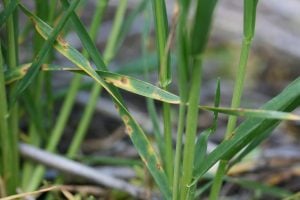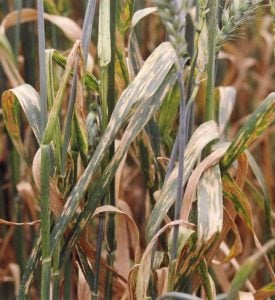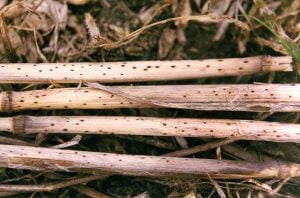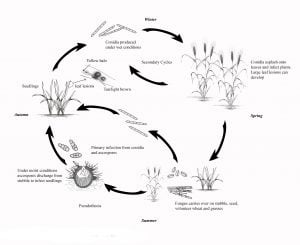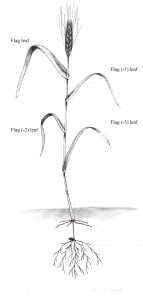Yellow leaf spot, also known as tan spot, is a widespread and important disease of wheat in Victoria. It is supported by stubble retention, intense wheat production in the rotation and widespread cultivation of susceptible wheat varieties.
In most years, yellow leaf spot only infects the lower leaves and is generally regarded as causing limited yield loss. However, in wet seasons (e.g. 2016) when susceptible wheat varieties are sown into wheat stubble, heavy infestations of yellow leaf spot can cause yield loss (up to 25%) when the flag and upper leaves become infected.
What to Look For
Yellow leaf spot is most often observed in seedlings, but when conditions are suitable (i.e wet conditions) it can progress up the plant.
The first symptoms appear on leaves as small tan oval spots or lesions surrounded by a yellow halo.
Individual lesions may vary in shape and size, often expanding and joining together with other lesions. The tips of severely affected leaves soon yellow and die.
Accurate disease identification is important as symptoms of yellow leaf spot can be confused with other disorders like aluminium toxicity or herbicide damage.
Disease Cycle
Yellow leaf spot, caused by the fungus Pyrenophora tritici- repentis, is predominantly a stubble-borne disease. The fungus survives from season to season on stubble and as the weather cools and rain occurs in autumn and late winter small black fruiting bodies will develop.
Fruiting bodies contain large numbers of ascospores which are forcibly ejected during humid conditions. Spores land on nearby wheat plants and will infect leaves if they remain wet for more than 6 hours. These ascospores have limited dispersal and typically only infect nearby plants within that paddock.
Often the early infection of seedlings does not progress to adult plants. However, when conditions are wet during the season and temperatures are between 10-25°C a second type of spore (conidia) is produced on the infected leaves. This secondary spore is dispersed by the wind and can result in rapid disease development higher up the plant, as well as into other wheat crops in the area. It is this secondary spread that causes higher yield losses.
Yellow (Leaf) Spot Management
Yellow leaf spot is most severe where successive wheat crops are grown on retained stubble. Rotating wheat with barley, oats or a non-cereal crop will reduce the impact of this disease. Foliar fungicides are registered to control yellow leaf spot, but they may not always be economical.
Management options include:
- Not sowing wheat into infected stubbles. A PreDicta®B test that includes stubble with the soil can be used to identify paddocks at risk of yellow leaf spot.
- Avoiding susceptible varieties. The pressure from yellow leaf spot will be greatly reduced if susceptible (S) and very susceptible varieties (VS) are replaced by varieties moderately susceptible (MS) or better to yellow leaf spot. Complete resistance is not needed to achieve sustainable control of this disease. For current yellow leaf spot resistance ratings see either the Victorian Cereal Disease Guide or the NVT website.
- Reducing the number of susceptible crops grown in a district will reduce inoculum load from season to season.
- Fungicides are most likely to give an economic return when yield potential is above 3.0 t/ha, a susceptible variety is being grown and 5 per cent of the Flag (-2) leaf and Flag (-3) leaf are affected. Under these conditions, a fungicide should be applied prior to, or just after rain. This will prevent the disease from moving up onto the flag leaf.
Seed and fertiliser treatments are not effective against this disease.
Please note: This book is also available on AppleBooks

